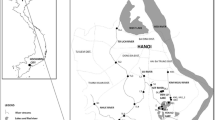Abstract
Polybrominated diphenyl ethers in Lake Ontario watershed sediments were assessed for benthic bioavailability through the use of biota-sediment accumulation factors. Sediments from lake and Rochester Harbor (lower Genesee River) areas were investigated. Congeners 47, 66, 85, 99 and 100 were detected in tissues of the oligochaete Lumbriculus variegatus. Biota-sediment accumulation factors ranged from 3.95 (congener 154) to 19.5 (congener 28) and were higher at the Lake Ontario area. The lower biota-sediment accumulation factors for the Rochester Harbor sediment may result from a higher fraction of black carbon generally expected in highly urbanized rivers. Degree of bromination may reduce bioavailability.


Similar content being viewed by others
References
Ciparis S, Hale RC (2005) Bioavailability of polybrominated diphenyl ether flame retardants in biosolids and spiked sediment to the aquatic oligochaete, Lumbriculus variegatus. Environ Toxicol Chem 24:916–925
Evandri MG, Costa LG, Bolle P (2003) Evaluation of brominated diphenyl ether-99 toxicity with Raphidocelis subcapitata and Daphnia magna. Environ Toxicol Chem 22:2167–2172
Ferguson PL, Chandler GT, Templeton RC, Demarco A, Scrivens WA, Englehart BA (2008) Influence of sediment-amendment with single-walled carbon nanotubes and diesel soot on bioaccumulation of hydrophobic organic contaminants by benthic invertebrates. Environ Sci Technol 42:3879–3885
Key PB, Hoguet J, Chung KW, Venturella JJ, Pennington PL, Fulton MH (2009) Lethal and sublethal effects of simvastatin, irgarol, and PBDE-47 on the estuarine fish, Fundulus heteroclitus. J Environ Sci Health Part B Pestic Food Contam Agric Waste 44:379–382
Law K, Halldorson T, Danell R, Stern G, Gewurtz S, Alaee M, Marvin C, Whittle M, Tomy G (2006) Bioaccumulation and trophic transfer of some brominated flame retardants in a Lake Winnipeg (Canada) food web. Environ Toxicol Chem 25:2177–2186
Leppanen MT, Kukkonen JVK (2004) Toxicokinetics of sediment-associated polybrominated diphenylethers (flame retardants) in benthic invertebrates (Lumbriculus variegatus, Oligochaeta). Environ Toxicol Chem 23:166–172
Lyytikainen M, Hirva P, Minkkinen P, Hamalainen H, Rantalainen AL, Mikkelson P, Paasivirta J, Kukkonen JVK (2003) Bioavailability of sediment-associated PCDD/Fs and PCDEs: relative importance of contaminant and sediment characteristics and biological factors. Environ Sci Technol 37:3926–3934
Nakari T, Huhtala S (2008) Comparison of toxicity of congener-153 of PCB, PBB, and PBDE to Daphnia magna. Ecotoxicol Environ Saf 71:514–518
Pickard SW, Clarke JU (2008) Benthic bioaccumulation and bioavailability of polychlorinated debenzo-p-dioxins/dibenzofurans from surficial Lake Ontario sediments. J Great Lakes Res 34:418–433
Pickard SW, Clarke JU, Lotufo GR (2005) Bioavailability of polycyclic aromatic hydrocarbons (PAHs) from surficial Lake Erie sediments. Bull Environ Contam Toxicol 76:791–798
Song WL, Ford JC, Li A, Sturchio NC, Rockne KJ, Buckley DR, Mills WJ (2005) Polybrominated diphenyl ethers in the sediments of the Great Lakes. 3. Lakes Ontario and Erie. Environ Sci Technol 39:5600–5605
Stapleton HM, Baker JE (2003) Comparing polybrominated diphenyl ether and polychlorinated biphenyl bioaccumulation in a food web in Grand Traverse Bay, Lake Michigan. Arch Environ Contam Toxicol 45:227–234
USAERDC (2006) BSAF Database. http://el.erdc.usace.army.mil/bsaf
USEPA, USACE (1998) Great Lakes dredged material testing and evaluation manual. http://www.epa.gov/glnpo/sediment/gltem/manual.htm
Wania F, Dugani CB (2003) Assessing the long-range transport potential of polybrominated diphenyl ethers: a comparison of four multimedia models. Bull Environ Contam Toxicol 22:1252–1261
Wollenberger L, Dinan L, Breitholtz M (2005) Brominated flame retardants: activities in a crustacean development test and in an ecdysteroid screening assay. Environ Toxicol Chem 24:400–407
Zhu LYZ, Hites RA (2004) Temporal trends and spatial distribution of brominated flame retardants in archived fishes from the Great Lakes. Environ Sci Technol 38:2779–2784
Acknowledgments
We thank our colleagues Dennis Rimer, Jay Miller, William Butler, David Swiatek, Timothy Crockett, Michael Asquith (USACE Buffalo District) and Jerre Sims (US Army Engineer Research and Development Center) for their support on this work.
Author information
Authors and Affiliations
Corresponding author
Rights and permissions
About this article
Cite this article
Lotufo, G.R., Pickard, S.W. Benthic Bioaccumulation and Bioavailability of Polybrominated Diphenyl Ethers from Surficial Lake Ontario Sediments Near Rochester, New York, USA. Bull Environ Contam Toxicol 85, 348–351 (2010). https://doi.org/10.1007/s00128-010-0088-8
Received:
Accepted:
Published:
Issue Date:
DOI: https://doi.org/10.1007/s00128-010-0088-8




